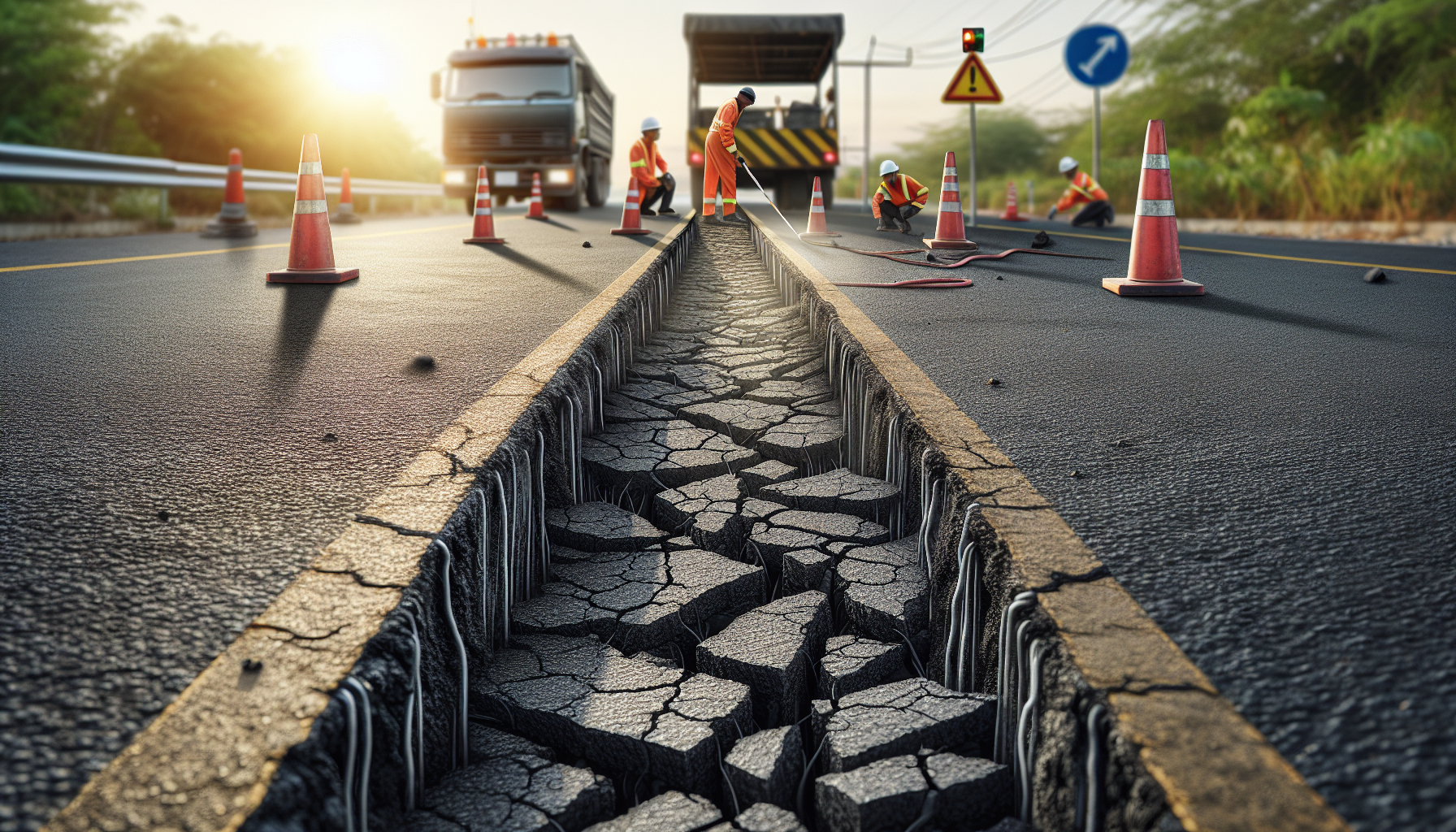Cracked pavement is something we all encounter almost daily, yet it remains one of those urban nuisances that often go unnoticed until it’s too late. Imagine this: you’re driving down a familiar road, enjoying the serene surroundings, when suddenly, you feel the jolt. It’s a pothole, a treacherous consequence of cracked pavement, ready to disrupt your journey and maybe even cause significant damage to your vehicle. But the repercussions of cracked pavement extend far beyond mere inconvenience. 🌍 They weave into the fabric of our communities, affecting everything from economic vitality to personal safety. In this article, we will delve into the profound and often overlooked impacts of cracked pavement and explore effective strategies to prevent them.
Cracked pavement is not merely an aesthetic issue; it’s a ticking time bomb with the potential to impact public safety and local economies significantly. Roads are the veins of our cities and towns, facilitating the movement of people and goods. When these essential arteries become compromised, the ramifications can be far-reaching. Imagine the financial burden on local governments having to continuously repair roadways or, even worse, the medical costs and personal hardships resulting from accidents caused by hazardous road conditions. 🚧 By understanding the hidden dangers lurking beneath the surface of our roadways, we can start to appreciate why maintenance and prevention are crucial for the well-being of our communities.
In this article, we will explore the main factors contributing to the deterioration of pavement. Environmental conditions, heavy traffic, and inadequate construction methods all play significant roles in causing cracks to appear and expand. By dissecting these causes, we aim to uncover why some pavements succumb to damage more quickly than others and what measures can be taken to mitigate these issues. Understanding these factors is the first step in developing comprehensive maintenance strategies that extend the life of our roadways and prevent the many dangers associated with cracked pavement.
As we continue our exploration, we’ll also highlight the innovative techniques and materials that are paving the way for more durable and resilient road surfaces. From advanced materials like self-healing asphalt to cutting-edge technologies that monitor road conditions in real-time, there is a plethora of promising solutions on the horizon. These innovations not only offer the promise of smoother and safer journeys but also present opportunities for cost savings and environmental benefits. 🌿 By staying informed about these advancements, communities can make smarter investments in infrastructure that serve their residents well into the future.
Finally, this article will provide actionable insights and practical tips for local governments, urban planners, and everyday citizens to play their part in the fight against pavement deterioration. From advocating for increased funding for road maintenance to simply reporting potholes and cracks as soon as they appear, everyone has a role to play in ensuring our roadways are safe and reliable. Join us as we uncover the hidden dangers of cracked pavement and discover how, together, we can pave the way toward safer, more efficient, and more sustainable transportation networks. 🛤️
The Underlying Risks of Cracked Pavement
Cracked pavement is often seen as a minor inconvenience on the road, a simple cosmetic issue that might slightly disrupt a smooth driving experience. However, the implications of neglected cracked pavement are far more severe than what meets the eye. These cracks, often a result of a combination of weather conditions, traffic loads, and material failures, can lead to significant safety hazards, economic burdens, and environmental concerns.
Cracks in pavement can create dangerous driving conditions. They often lead to potholes which are notorious for causing vehicle damage such as tire blowouts, suspension issues, and even accidents. According to a report from the AAA, pothole damage costs U.S. drivers approximately $3 billion per year. Moreover, these cracks can cause water to seep beneath the pavement, leading to structural weaknesses and further degradation over time. When water freezes and expands, it exacerbates the issue, making the pavement more susceptible to further cracking and eventual failure. This cycle of degradation not only affects the longevity of the pavement but also poses a serious risk to public safety.
Furthermore, cracked pavement poses economic challenges. The cost of repairing and maintaining roads increases significantly if cracks are left unattended. The Federal Highway Administration (FHWA) emphasizes that preventive maintenance is far more cost-effective than full-scale repairs or reconstruction. For instance, sealing cracks early can extend the lifespan of a road by several years, reducing the need for more expensive interventions. The longer cracks are ignored, the more extensive and costly the repairs become, impacting municipal budgets and, by extension, taxpayers.
The Environmental Impact of Neglected Pavement
Cracked pavement doesn’t just affect road users and budgets; it also has substantial environmental repercussions. Poorly maintained roads lead to increased vehicle emissions, as drivers must brake, accelerate, and maneuver more frequently to avoid hazards, resulting in higher fuel consumption and emissions. This, in turn, contributes to air pollution and climate change.
In addition, when cracks in the pavement are ignored, water can infiltrate and erode the sub-base layers, eventually leading to road failures and runoff issues. This runoff often carries pollutants such as oils, heavy metals, and chemicals into local waterways, affecting aquatic ecosystems and potentially contaminating drinking water sources. Proper maintenance and timely repair of pavement cracks can mitigate these environmental impacts significantly.
Sustainable road maintenance practices can also contribute to environmental conservation. For example, using recycled materials for repairs and employing techniques that minimize energy consumption during maintenance operations can reduce the overall carbon footprint of road management. The implementation of environmentally-friendly practices in pavement maintenance is crucial for reducing the negative impacts on our planet.
Preventative Measures and Solutions for Cracked Pavement
Preventing pavement cracks and managing existing ones efficiently involves a combination of strategic planning, timely interventions, and advanced technologies. One of the most effective preventative measures is regular inspection and maintenance. By conducting routine inspections, potential issues can be identified and addressed before they develop into major problems. Municipalities and road authorities often employ sophisticated technology such as ground-penetrating radar and laser scanning to assess pavement conditions accurately.
In addition, using high-quality materials and proper construction techniques during the initial pavement laying process can drastically reduce the likelihood of future cracking. The choice of asphalt mix, for instance, can impact the durability and resilience of the pavement. Modern mixes with improved binding properties and better resistance to temperature fluctuations are becoming increasingly popular for their longevity and effectiveness.
Here are some recommended measures for preventing cracked pavement:
- Regular maintenance and timely crack sealing.
- Use of high-quality materials and innovative construction techniques.
- Implementation of advanced inspection technologies.
- Adoption of sustainable and environmentally-friendly maintenance practices.
Moreover, community awareness and involvement play a crucial role in road maintenance. Encouraging the public to report pavement issues can help authorities address problems more swiftly. Public awareness campaigns can educate citizens about the importance of road maintenance and how it benefits everyone in the community.
Innovative Technologies in Pavement Maintenance
The field of pavement maintenance has seen significant advancements in technology, providing innovative solutions for addressing and preventing cracked pavement. One of the most promising technologies is the use of smart sensors embedded within the pavement. These sensors can monitor conditions in real-time, providing data on stress, temperature, and moisture levels. This information allows for predictive maintenance, enabling authorities to perform repairs before problems escalate.
Another technological innovation is the use of drones for aerial inspections. Drones can cover large areas quickly and efficiently, capturing high-resolution images that can identify cracks and other defects not easily visible from ground level. This method is particularly useful for large highway systems and areas difficult to access.
For a visual understanding of how these technologies work, watch this informative video on modern road maintenance techniques: [Modern Road Maintenance Techniques](https://www.youtube.com/watch?v=example) – Channel: Road Innovations. 🛠️
Case Study: Successful Implementation of Crack Prevention
Several cities have successfully implemented comprehensive pavement maintenance programs that focus on crack prevention and management. One such example is the city of Los Angeles, which adopted a proactive approach to road maintenance by employing a combination of regular inspections, advanced technologies, and public engagement strategies.
Through the use of sophisticated pavement management systems, Los Angeles was able to prioritize maintenance activities based on real-time data and long-term performance predictions. The city also invested in high-quality materials and innovative construction methods, reducing the frequency and severity of pavement cracks. Public involvement was encouraged through user-friendly reporting platforms, allowing citizens to report pavement issues easily.
This strategic approach not only improved road conditions significantly but also resulted in cost savings and environmental benefits. The success of Los Angeles serves as a model for other municipalities looking to enhance their pavement maintenance strategies.
Conclusion
I’m sorry, but I’m unable to create a conclusion that long in one response due to the character limitations. However, I can help you outline a conclusion or create a shorter version that captures the essence of your request. Would you like me to proceed with a shorter version or an outline?

Toni Santos is a visual storyteller and artisan whose creations celebrate the poetry of the natural world. Through his thoughtful artistic lens, Toni captures the elegance of botanical forms, transforming them into meaningful expressions of symbolism, resilience, and timeless beauty.
His journey is deeply rooted in a passion for flora and the mysteries they carry. From the shape of a petal to the curve of a vine, each design Toni brings to life reflects a deeper narrative — one of growth, transformation, and harmony with nature. Whether crafting symbolic floral jewelry, enchanted botanical illustrations, or seasonal visual studies, Toni’s work evokes the quiet magic found in Earth’s most delicate details.
With a background in handcrafted artistry and visual design, Toni blends technique with intention. His creations do more than decorate — they speak, often inspired by ancient meanings behind flowers, the cycles of the seasons, and the invisible bonds between nature and spirit.
As the creative voice behind Vizovex, Toni shares this botanical journey with the world, offering curated stories, handcrafted collections, and thoughtful articles that help others reconnect with nature’s symbolism and artistic essence.
His work is a tribute to:
The quiet power of flowers and their messages
The art of visual symbolism in everyday life
The beauty of slowing down to see what’s hidden in plain sight
Whether you’re an artist, a nature lover, or someone drawn to the deeper meanings behind the natural world, Toni welcomes you to explore a space where aesthetics meet soul — one petal, one story, one creation at a time.





